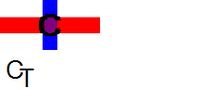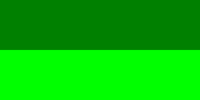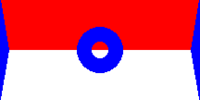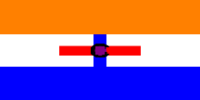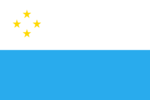Flags of Craitland: Difference between revisions
From MicrasWiki
Jump to navigationJump to search
| Line 111: | Line 111: | ||
| width4 = 150 | | width4 = 150 | ||
| alt4 = | | alt4 = | ||
| caption4 = Former flag of [[Talenore]], 2014–16: | | caption4 = Former flag of [[Talenore]], 2014–16:<br>Used by the territory during its initial period as an independent nation and preserved after becoming a Craitish protectorate in 2016. As an island, the blue band symbolised water, while the white represented the sky. The four gold stars stood for the four primary ethnic groups that comprised the nation; the [[Babkhi]], the [[Elw]], the [[Istvanistani]] and the [[Sani]]. | ||
| image5 = Talenore flag large.png | | image5 = Talenore flag large.png | ||
| width5 = 180 | | width5 = 180 | ||
| alt5 = | | alt5 = | ||
| caption5 = Flag of [[Talenore]]: | | caption5 = Flag of [[Talenore]]:<br>During Craitish protection, the Talenorean flag was redesigned to a horizontal tricolour, with each band signifying one of the three dominant ethnic groups in the island's shifting demographics. The Sani being represented by the green, the Babkhi by the red, and the Elw by the blue. This flag has remained in use by Talenore following its second independence in 2017 and subsequently its current protection by [[Shireroth]]. | ||
}} | }} | ||
Revision as of 14:00, 9 May 2020
The Kingdom of Craitland uses a number of flags at different administrative levels, with each of the nation's six provinces and four autonomous territories all flying a design separate to that of the national flag.
National flag
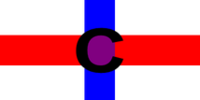 National flag of Craitland | |
| Use | National flag and ensign |
|---|---|
| Proportion | 1:2 |
| Adopted | December 2002 |
| Design | A white field with a centred cross combining a red horizontal stripe and a blue vertical stripe, forming a central purple square superimposed by a black letter "C". |
| Designer | Craitman H. Pellegrino |
Design and symbolism
Provincial flags
Flag of Cherry Trees (1:2):
The national flag in the canton signifies the home of the capital city, with the province's recognised colour of white, symbolising its proximity to the polar ice cap, completing the field. The stylised letters "CT" is a commonly used symbol for the province.
The national flag in the canton signifies the home of the capital city, with the province's recognised colour of white, symbolising its proximity to the polar ice cap, completing the field. The stylised letters "CT" is a commonly used symbol for the province.
Flag of Jedu (1:2):
Comprised of two islands, the province's flag has a blue field to represent the sea while the larger white square symbolises Jedu-ó-Kuiĵ and the smaller Jedu-ó-Carä. The positioning of the two squares is designed to loosely replicate the shape of a capital letter "J".
Comprised of two islands, the province's flag has a blue field to represent the sea while the larger white square symbolises Jedu-ó-Kuiĵ and the smaller Jedu-ó-Carä. The positioning of the two squares is designed to loosely replicate the shape of a capital letter "J".
Flag of Klevets-ó-Sdaa (1:2):
The darker shade of green symbolises the forests found throughout Klevets county, while the lighter green represents the pastures of Róndsdaa county; the two most populated counties in the province.
The darker shade of green symbolises the forests found throughout Klevets county, while the lighter green represents the pastures of Róndsdaa county; the two most populated counties in the province.
Flag of Metzreäiĵer (1:2):
The province's two most notable geographic features are represented by the blue at the base, for its extensive coastline, and the purple above, signifying the Hänä mountain range. The nation's highest point, Hänävissen, is symbolised by the white triangle in the centre.
The province's two most notable geographic features are represented by the blue at the base, for its extensive coastline, and the purple above, signifying the Hänä mountain range. The nation's highest point, Hänävissen, is symbolised by the white triangle in the centre.
Flag of Obsĵaiduņ (1:2):
While red and white are the province's recognised colours, little is known of their symbolism. The blue letter "O" in the centre stands for its name, with the chevrons at the hoist and fly pointing inwards to signify that it has the lowest mainland population.
While red and white are the province's recognised colours, little is known of their symbolism. The blue letter "O" in the centre stands for its name, with the chevrons at the hoist and fly pointing inwards to signify that it has the lowest mainland population.
Flag of Unstjeiädón (1:2):
As the province with the longest coastline, the primarily blue field represents its maritime history. The stylised letter "U" indicates its name, while the green half-border is representative of its location at the south of Craitland.
As the province with the longest coastline, the primarily blue field represents its maritime history. The stylised letter "U" indicates its name, while the green half-border is representative of its location at the south of Craitland.
Territorial flags
Flag of Incontinentia (1:2):
Designed in 2010 by Ramazan Tarekseev to replace the original flag after the territory gained increased autonomy. The white maintains its link to Craitland, with the two blue bands representing its coastline on both the Captive Sea and Sea of Storms. A central golden sun signifies a new dawn of self-governing.
Designed in 2010 by Ramazan Tarekseev to replace the original flag after the territory gained increased autonomy. The white maintains its link to Craitland, with the two blue bands representing its coastline on both the Captive Sea and Sea of Storms. A central golden sun signifies a new dawn of self-governing.
Flag of Lakkvia (2:3):
The blue and white halves are designed to imitate the design of the flag of the former Hurmu, of which the territory is a quasi-successor, with the black cross a sign of mourning for those killed in the Hurmu Genocide. The shape of the cross was inspired by the flag of the nearby Stormark, with whom Hurmu had much shared history, and the shield represents Craitland's protection of its people.
The blue and white halves are designed to imitate the design of the flag of the former Hurmu, of which the territory is a quasi-successor, with the black cross a sign of mourning for those killed in the Hurmu Genocide. The shape of the cross was inspired by the flag of the nearby Stormark, with whom Hurmu had much shared history, and the shield represents Craitland's protection of its people.
Flag of New Vaduz (1:2):
Influenced by Liechtenstein, the flag borrows heavily from the symbols of the namesake capital Vaduz, inverting the colours of its flag and rotating it to a landscape proportion. The crown is found on the coat of arms of Vaduz, and was repurposed to represent the crown of the Prince of New Vaduz; a substantive title given to a senior member of the Craitish royal family.
Influenced by Liechtenstein, the flag borrows heavily from the symbols of the namesake capital Vaduz, inverting the colours of its flag and rotating it to a landscape proportion. The crown is found on the coat of arms of Vaduz, and was repurposed to represent the crown of the Prince of New Vaduz; a substantive title given to a senior member of the Craitish royal family.
Flag of Zandarijn (1:2):
The orange, white and blue tricolour was the flag utilised by Zandarijn during its short-lived statehood under the United States of Amoria; a design in turn inspired by the traditional Prince's Flag used by the Dutch, whose culture influenced the territory's. Upon being annexed by Craitland, the centre of the middle band was superimposed with the Craitish national flag. Its overall design is unintentionally similar to the so-called "apartheid flag".
The orange, white and blue tricolour was the flag utilised by Zandarijn during its short-lived statehood under the United States of Amoria; a design in turn inspired by the traditional Prince's Flag used by the Dutch, whose culture influenced the territory's. Upon being annexed by Craitland, the centre of the middle band was superimposed with the Craitish national flag. Its overall design is unintentionally similar to the so-called "apartheid flag".
Cultural flags
Former flags
Former flag of Incontinentia, 2007–10:
Designed by the territory's creator in 2003 prior to its annexation by Craitland shortly after, the design was preserved throughout the territory's inclusion on Micras in 2007 until an increase in autonomy in 2010. The black field was used due to its anarchist symbolism, with the canton displaying a modified peace sign in red.
Designed by the territory's creator in 2003 prior to its annexation by Craitland shortly after, the design was preserved throughout the territory's inclusion on Micras in 2007 until an increase in autonomy in 2010. The black field was used due to its anarchist symbolism, with the canton displaying a modified peace sign in red.
Former flag of New South Vietnam, 2008:
A protectorate of Craitland for a number of months in 2008, the flag was a modified variant of the one it used when under the rule of New Brittania, where the Brittanic flag was placed in the canton. The design of the field was repurposed from Chi Nam's, itself inspired by the flag of South Vietnam. Under Craitland, the Craitish national flag was placed in the centre to mimic the layout of Zandarijn's.
A protectorate of Craitland for a number of months in 2008, the flag was a modified variant of the one it used when under the rule of New Brittania, where the Brittanic flag was placed in the canton. The design of the field was repurposed from Chi Nam's, itself inspired by the flag of South Vietnam. Under Craitland, the Craitish national flag was placed in the centre to mimic the layout of Zandarijn's.
Flag of Passas:
Former flag of Talenore, 2014–16:
Used by the territory during its initial period as an independent nation and preserved after becoming a Craitish protectorate in 2016. As an island, the blue band symbolised water, while the white represented the sky. The four gold stars stood for the four primary ethnic groups that comprised the nation; the Babkhi, the Elw, the Istvanistani and the Sani.
Used by the territory during its initial period as an independent nation and preserved after becoming a Craitish protectorate in 2016. As an island, the blue band symbolised water, while the white represented the sky. The four gold stars stood for the four primary ethnic groups that comprised the nation; the Babkhi, the Elw, the Istvanistani and the Sani.
Flag of Talenore:
During Craitish protection, the Talenorean flag was redesigned to a horizontal tricolour, with each band signifying one of the three dominant ethnic groups in the island's shifting demographics. The Sani being represented by the green, the Babkhi by the red, and the Elw by the blue. This flag has remained in use by Talenore following its second independence in 2017 and subsequently its current protection by Shireroth.
During Craitish protection, the Talenorean flag was redesigned to a horizontal tricolour, with each band signifying one of the three dominant ethnic groups in the island's shifting demographics. The Sani being represented by the green, the Babkhi by the red, and the Elw by the blue. This flag has remained in use by Talenore following its second independence in 2017 and subsequently its current protection by Shireroth.
| |||||||||||||||||||||||||||||
